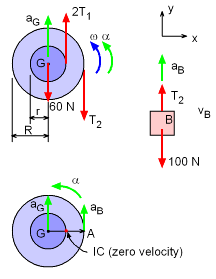| Ch 6. Rigid Body Force and Acceleration | Multimedia Engineering Dynamics | ||||||
|
Moment of Inertia |
Translational Motion | Fixed Point Rotation |
General Plane Motion |
||||
| General Plane Motion | Case Intro | Theory | Case Solution | Example |
| Chapter |
| - Particle - |
| 1. General Motion |
| 2. Force & Accel. |
| 3. Energy |
| 4. Momentum |
| - Rigid Body - |
| 5. General Motion |
| 6. Force & Accel. |
| 7. Energy |
| 8. Momentum |
| 9. 3-D Motion |
| 10. Vibrations |
| Appendix |
| Basic Math |
| Units |
| Basic Dynamics Eqs |
| Sections |
| eBooks |
| Dynamics |
| Fluids |
| Math |
| Mechanics |
| Statics |
| Thermodynamics |
| ©Kurt Gramoll |
|
|
||
 Rotating Spool |
Example |
|
|
A spool, G, is hung from a ceiling and a block, B, is attached to its outer surface with a cable as shown. The block weighs 100 N and the spool weighs 60 N. The spool's radius of gyration is 3 cm with respect to its mass center, G. It has outer radius, R, of 4 cm and inner radius, r, of 2 cm. If the system is released from rest in the position shown, what is the acceleration of the mass center G? |
||
| Solution |
||
|
|
The equations of motion for the block, These three equations have five unknowns, so additional relationships need to be identified. One idea is to use the IC point to relate α and the two linear accelerations, aGy and aB. At the instant given, the spool is pivoting around the point where the ceiling cable is attached to the spool, and thus has zero velocity. Thus, Putting these into the above three equations, Combining into two equations, Eliminate T1, gives, Thus, the spool center, G, is accelerating upward, aGy = 1.330 m/s2 |
|
Practice Homework and Test problems now available in the 'Eng Dynamics' mobile app
Includes over 400 free problems with complete detailed solutions.
Available at the Google Play Store and Apple App Store.
